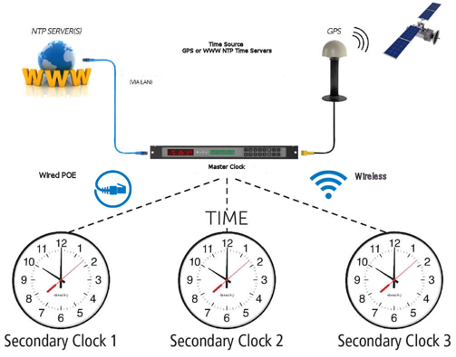Synchronzied Clocks Systems
Don't Waste Time on Time
- Do all the clocks in your facility show the same precise time?
- Are maintenance staff constantly spending time adjusting clocks and correcting for daylight saving time twice a year?
- Are staff showing up late for meetings?
- Are shift changes not coordinated
- Different break times
Solve all this with a Synchronized Clock System
A synchronized clock system is when the all the display clocks in your building all show the exact same time and automatically and update twice a year for daylight saving time. This ensures that maintenance teams are spending more time on other priorities – rather than adjusting clocks
A synchronized clock system typically consists of a “master clock” and multiple “secondary clocks” also known as “slave clocks”. The master clock communicates with all the secondary clocks in the system to provide them with an accurate time source. So no matter what part of the building or campus you are in all the clocks will be uniform and accurate.

How does it work?
In a synchronized clock system, the master clock maintains accurate time from either an NTP server (ie NRC) or GPS. When the master clock has received the correct time from either source, the time is then distributed to all slave clocks in the system. The signal is sent to the clocks multiple times per day, ensuring that all clocks stay synchronized and do not drift from their accurate time.


Wired System
With a wired system the master clock is wired to each clock in the building and controls the displayed time. Clock options for this system include energy-efficient Power over Ethernet (PoE) clocks that receive power and time updates from one cable connected to your Ethernet.
Wireless System
In an existing building where extending an existing wired system can be too expensive, a wireless system eliminates the need of running wires from the master clock to each clocks in the building. Two types of wireless systems are available.
- 900 Mhz Wireless System: The master clock using an open radio frequency will send a signal to each wireless clock designed to receive this signal. Each clock will also act as a repeater extending the range of the wireless system.
- WiFi Clocks: A second option is using your existing WiFi infrastructure. Each clock will interface with your facility’s existing Wi-Fi infrastructure to receive time from a common NTP time source.
BENEFITS TO HAVING A SYNCHRONIZED CLOCK SYSTEM
- Everyone in the facility is on the same time
- Eliminate maintenance staff correcting for daylight saving time twice a year
- Clocks re-adjust to the correct time after a power failure
- MasterClock can also schedule ringing of bells, turning on heating/air conditioning at predetermined times
- Using the added features like count up and countdown allows you to show elapsed time between breaks, shifts, for “Code Blue” in hospitals

